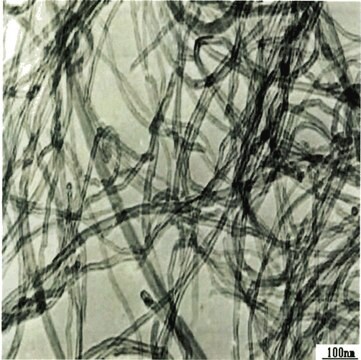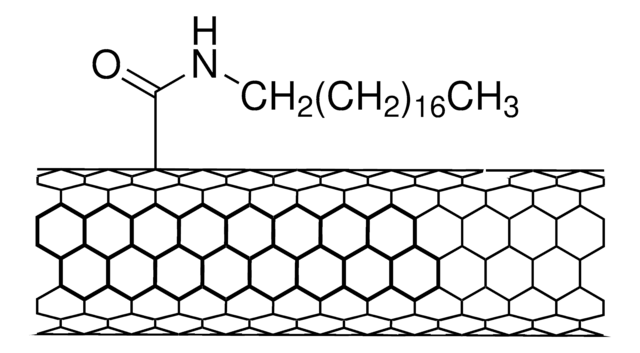755125
Carbon nanotube, multi-walled
carboxylic acid functionalized,>90% carbon basis, D × L 9.5 nm × 1.5 μm
Synonyme(s) :
Carbon nanotube, multi-walled, carboxylic acid functionalized
About This Item
Produits recommandés
product name
Carbon nanotube, multi-walled, carboxylic acid functionalized, thin, extent of labeling: >8% carboxylic acid functionalized, avg. diam. × L 9.5 nm × 1.5 μm
Description
carboxylic acid functionalized
Niveau de qualité
Pureté
>80% carbon basis
Forme
powder
Caractéristiques du produit alternatif plus écologique
Design for Energy Efficiency
Learn more about the Principles of Green Chemistry.
sustainability
Greener Alternative Product
Ampleur du marquage
>8% carboxylic acid functionalized
Diam. moyen × L
9.5 nm × 1.5 μm
Groupe fonctionnel
carboxylic acid
Autre catégorie plus écologique
, Enabling
Description générale
Application
Deposition (CCVD) process. Applications include Electronics; 1 Sensors; 2 Composites; Energy Storage and Study of Life Science systems.3
Notes préparatoires
Informations légales
Code de la classe de stockage
13 - Non Combustible Solids
Classe de danger pour l'eau (WGK)
WGK 3
Point d'éclair (°F)
Not applicable
Point d'éclair (°C)
Not applicable
Faites votre choix parmi les versions les plus récentes :
Déjà en possession de ce produit ?
Retrouvez la documentation relative aux produits que vous avez récemment achetés dans la Bibliothèque de documents.
Les clients ont également consulté
Articles
Boron nitride nanotubes (BNNT) are close structural analogs of carbon nanotubes (CNT), which are high aspect ratio nanotubular material, where carbon atoms are alternately substituted by nitrogen and boron atoms.
Professor Rivnay (Northwestern University, USA) discusses using organic mixed conductors as an alternative to efficiently bridge the ionic world of biology with contemporary microelectronics.
Carbon nanotubes (CNTs) have received much attention since their discovery in 1991 by Sumio lijima1 due to their excellent mechanical, electrical, and optical properties.
A nanocomposite is typically defined as a mixture between a host material (e.g., polymer matrix) and nanofillers with at least one dimension of less than 100 nm.
Notre équipe de scientifiques dispose d'une expérience dans tous les secteurs de la recherche, notamment en sciences de la vie, science des matériaux, synthèse chimique, chromatographie, analyse et dans de nombreux autres domaines..
Contacter notre Service technique





